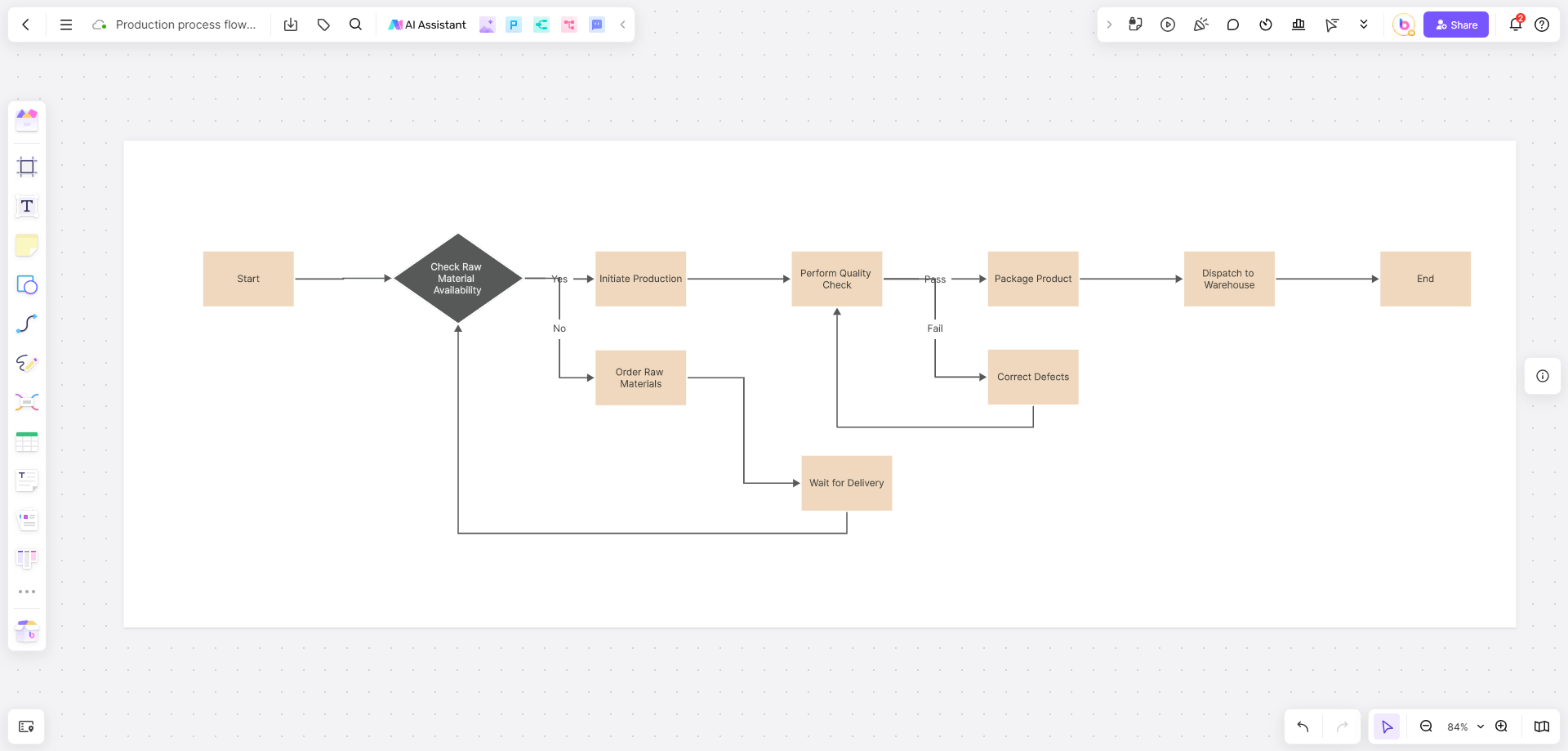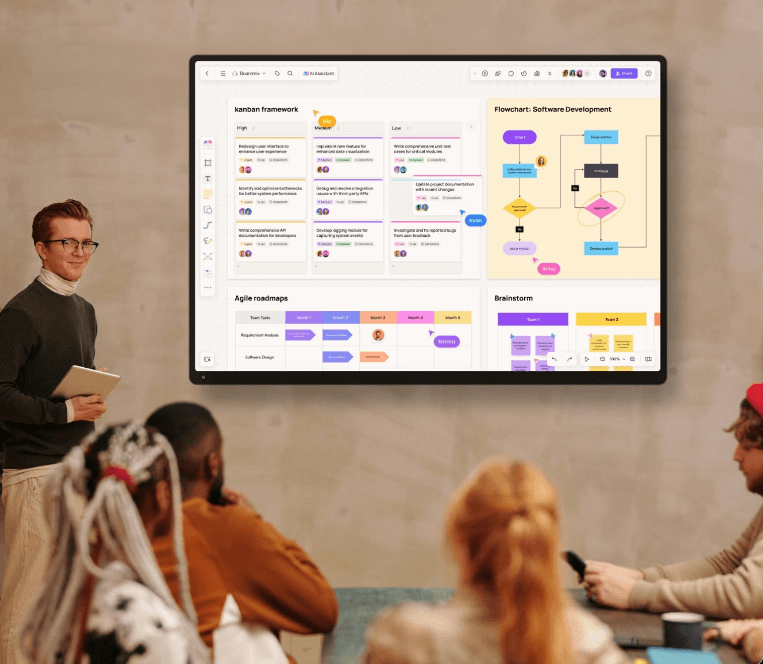If you are looking for a tool to create nursing concept maps easily and efficiently, Boardmix is worth trying. This is a platform suitable for online team collaboration, especially for team collaboration and management. By integrating nursing content into one platform, medical teams can collaborate seamlessly. Next, let’s explore why Boardmix is great for creating nursing concept and how to creating a nursing concept map with ready-made nursing templates easily.
Steps to Create Nursing Concept Maps in Boardmix
Step 1. Choose a Central Topic
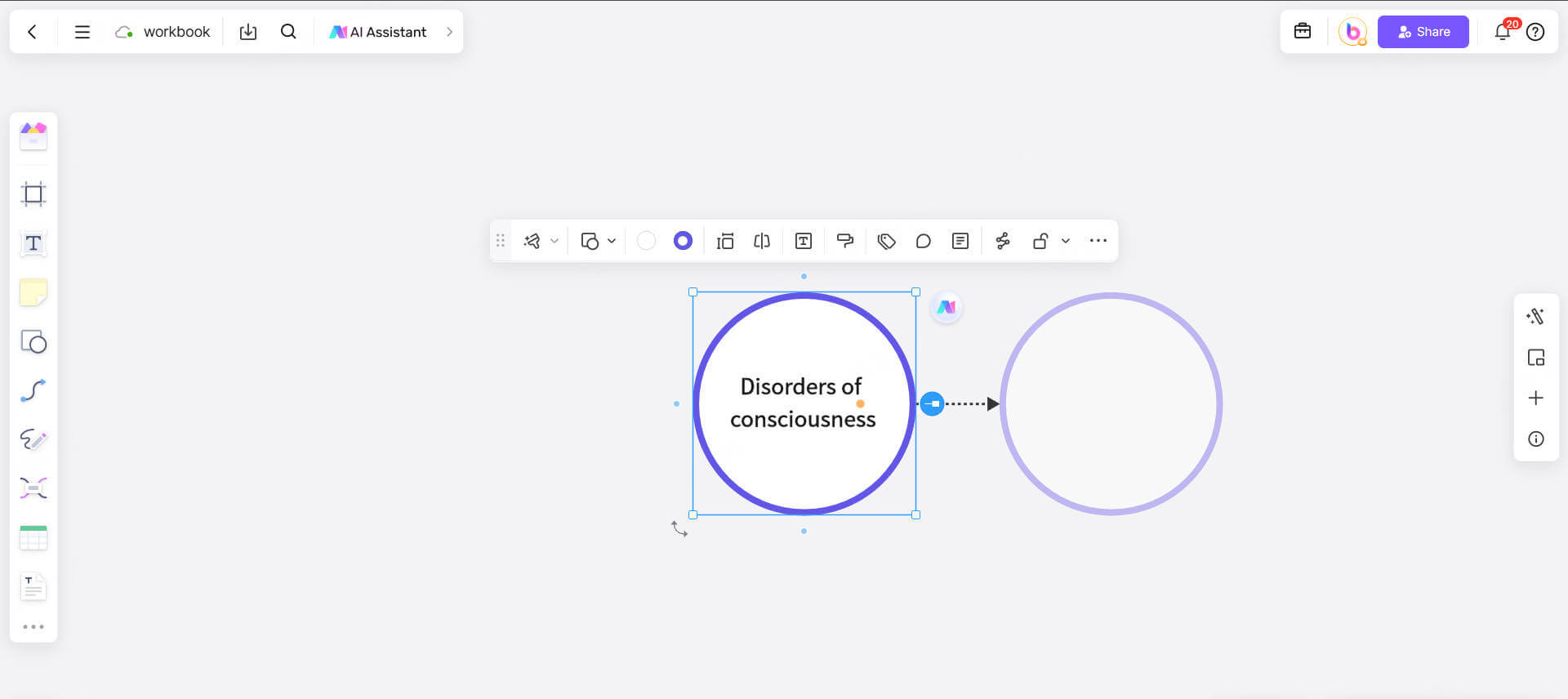
Start by identifying the primary focus of your concept map. This could be a specific disease (e.g., diabetes), a nursing diagnosis, or a patient case study.
In Boardmix, simply create a new mind map and type the central topic in the main node.
Step 2. Add Key Symptoms and Related Conditions
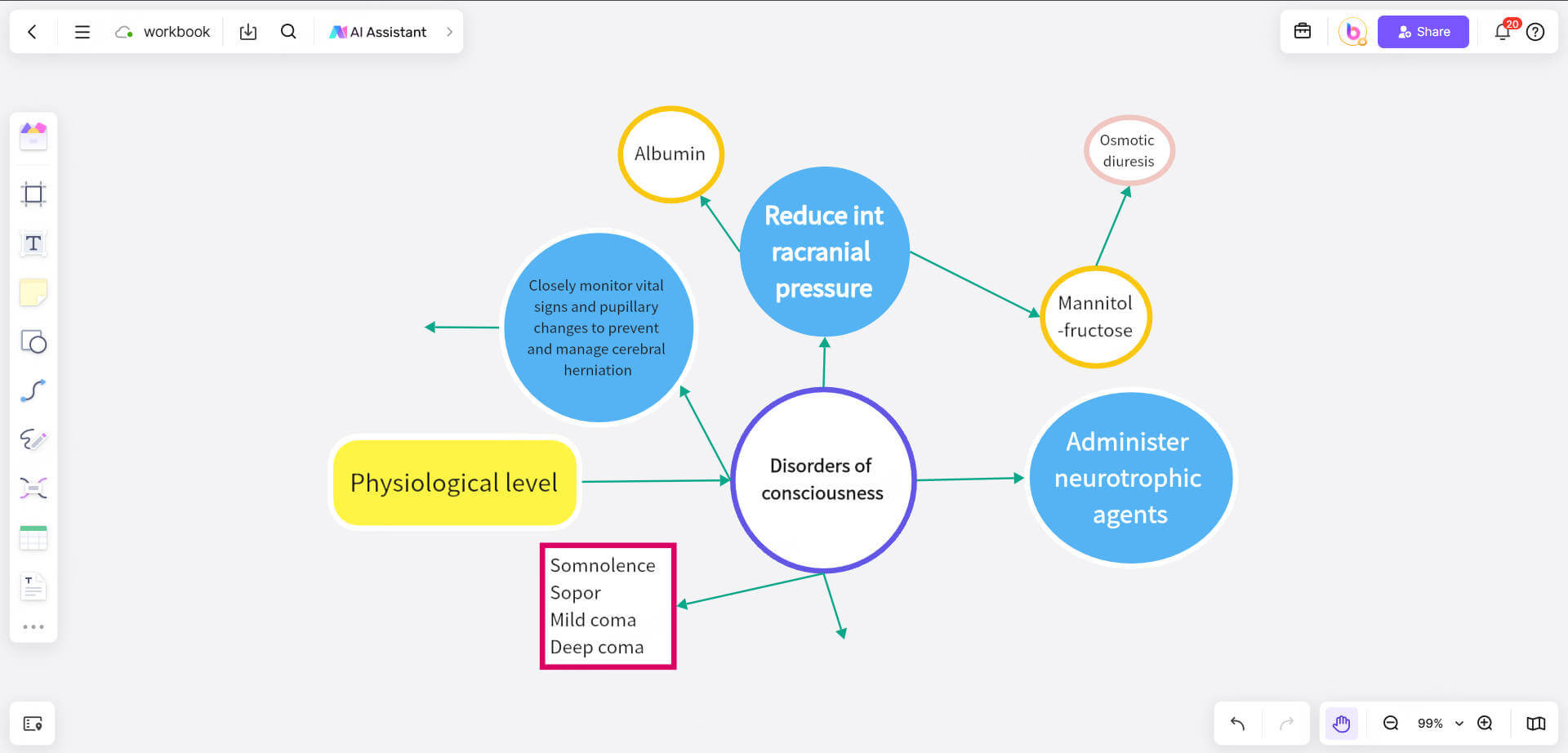
Branch out from the central topic by adding major symptoms and conditions associated with the patient’s case.
Use Boardmix's drag-and-drop feature to easily organize related concepts without clutter.
Step 3. Connect Interventions and Nursing Actions
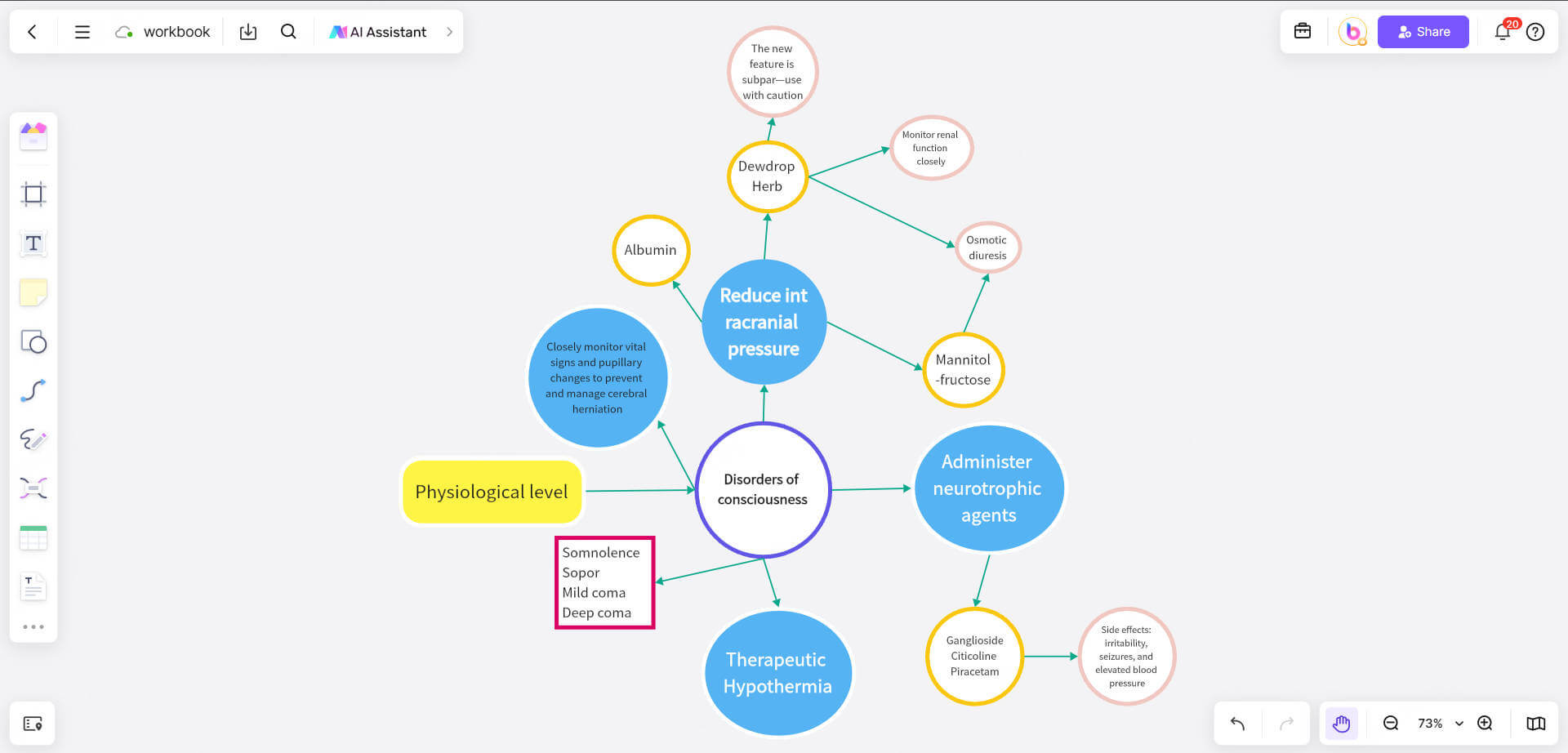
Under each symptom or condition, list potential nursing interventions and treatments.
Use arrows or color coding to show relationships between symptoms and treatments.
Add medical guidelines or patient history as notes for reference.
Step 4. Include Patient Outcomes and Monitoring Plans
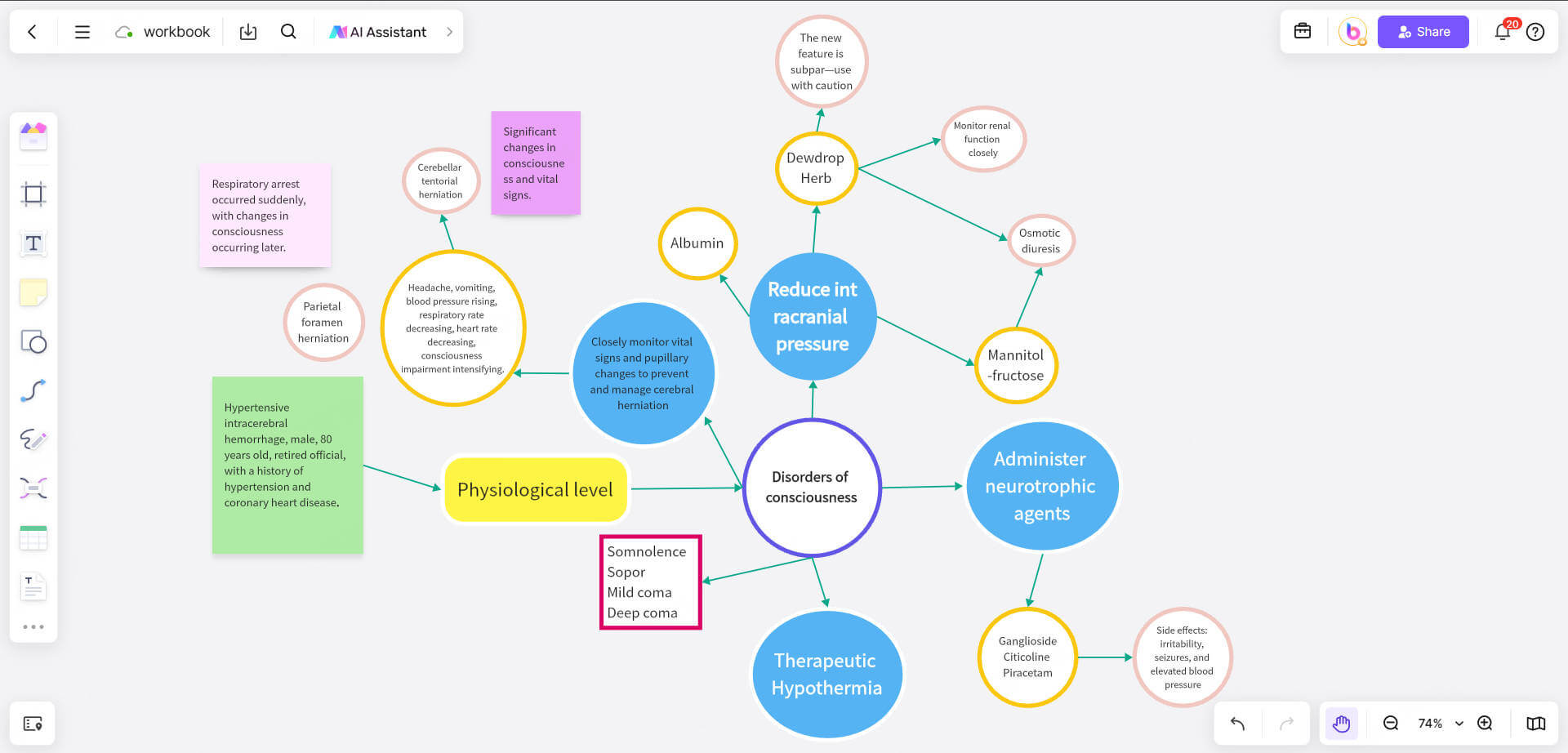
A concept map isn’t just about treatments—it also tracks patient progress.
Add sections for expected outcomes, potential complications, and follow-up care.
In Boardmix, you can attach reference materials, images, or external links for deeper insights.
Tips for Making an Effective Nursing Concept Map
- Keep It Clear and Organized
Avoid overloading the map with too much text—keep nodes concise.
Use colors, icons, or labels to differentiate symptoms, interventions, and outcomes.
- Collaborate with Your Team
Boardmix allows real-time collaboration, so you can build concept maps with colleagues.
Team members can leave comments, suggest edits, or add insights to improve patient care plans.
- Update the Map as Needed
Nursing plans evolve with patient conditions, so update the concept map regularly.
Use Boardmix’s version history to track changes and review past assessments.
Why Use Boardmix to Create Nursing Concept Maps?
Easy-to-use drag-and-drop operation
Boardmix's drag-and-drop operation interface allows nurses to build professional-level concept maps without design foundation. In the emergency scenario, nurses can quickly drag in the "chest pain symptoms" node and associate electrocardiogram results and nitroglycerin medication records to complete the visualization of the nursing path of patients with acute angina pectoris within 5 minutes.
Multi-terminal synchronous collaboration breaks the time and space barriers of nursing
Through the real-time collaboration function in the cloud, ICU doctors, pharmacists, and responsible nurses can simultaneously annotate the same nursing map for sepsis patients. This mode effectively solves the blind spot of cross-shift handovers-the pain assessment data added by the night shift nurse will be displayed in real time on the tablet of the day shift team to ensure nursing continuity.
Standardized and various types of nursing templates
Boardmix's built-in specialized templates such as diabetes management and postoperative rehabilitation can increase the assessment efficiency of newly admitted patients by more than 60%. For example, after selecting the "Pressure Ulcer Prevention Template", the system automatically generates a framework including a turning frequency calculator, a skin assessment scale, and a nutrition support module. The nurse only needs to fill in the patient's specific data.
Multiple formats of information are integrated into one platform
Supports the insertion of multimodal data such as CT images, wound photos, and PDF test reports, making the concept map a "three-dimensional sand table" for patient health information. Users can save attachments such as patient records, images, and reports in one place for efficient collaboration.
In the oncology department, nurses can embed PET-CT images into nursing maps and directly mark the correspondence between the location of metastases and pain management plans; social workers can attach psychological assessment recordings to achieve full integration of the bio-psycho-social medical model.
Multi-view switching enables clinical reasoning
The same case data can be switched to a concept map (pathological mechanism analysis), a flow chart (operation timing planning), and a mind map (intervention measures divergence) through a button.
For example, when dealing with patients with chronic heart failure: use the concept map mode to sort out the vicious cycle of "fluid retention-diuretic resistance-renal insufficiency"; switch to the flowchart to formulate daily intake and output monitoring steps; list non-drug intervention alternatives through mind maps to achieve three-dimensional decision verification.
AI intelligent suggestions help diagnose complex cases
Enter keywords such as "Alzheimer's disease, agitated behavior, renal insufficiency", and AI automatically generates a nursing framework including cognitive training programs, psychiatric drug dosage adjustment warnings, and anti-fall intervention levels.
Historical versions for tracing the nursing path
Completely record the traces of each nursing plan modification, including the person who modified it, the time point, and the specific changes. When a medical dispute occurs, the historical version can be retrieved to prove that the nursing measures are in compliance with the regulations.
Cloud-based nursing collaboration
Update the nursing map on-site in the ward through a tablet, and the data is synchronized to the large screen of the nurse station and the doctor's mobile phone in real time. In the outpatient care scenario, community nurses can use their mobile phones to check the latest version of the nursing map when they visit patients at home. After uploading the home blood sugar monitoring data, the hospital nutritionist can adjust the dietary recommendations immediately, forming a closed-loop smart care network.
Boardmix not only revolutionizes the presentation of nursing concept maps, but also reconstructs clinical workflows. From rapid response in the emergency room to long-term tracking of chronic disease management, from single-department nursing to MDT multidisciplinary collaboration, its technical characteristics are deeply integrated with nursing expertise to help nursing work be presented in a more efficient and collaborative way.
Types of Nursing Map for Patient Care
There are three types of Nursing Maps commonly used for nursing patients: Nursing Concept Map, Nursing Flowchart and Nursing Mind Map. These three types of tools complement each other: concept maps emphasize overall connections, flow charts standardize operation sequences, and mind maps stimulate innovation dimensions.
In clinical practice, the choice of which map to use needs to be combined with the goal and the complexity of the scenario. For example, you need to consider whether your goal is for systematic analysis, process control or creative generation. If the nursing scenario is a single problem, use a flow chart, and if it is multi-dimensional interweaving, use a concept map.
1. Nursing Concept Map
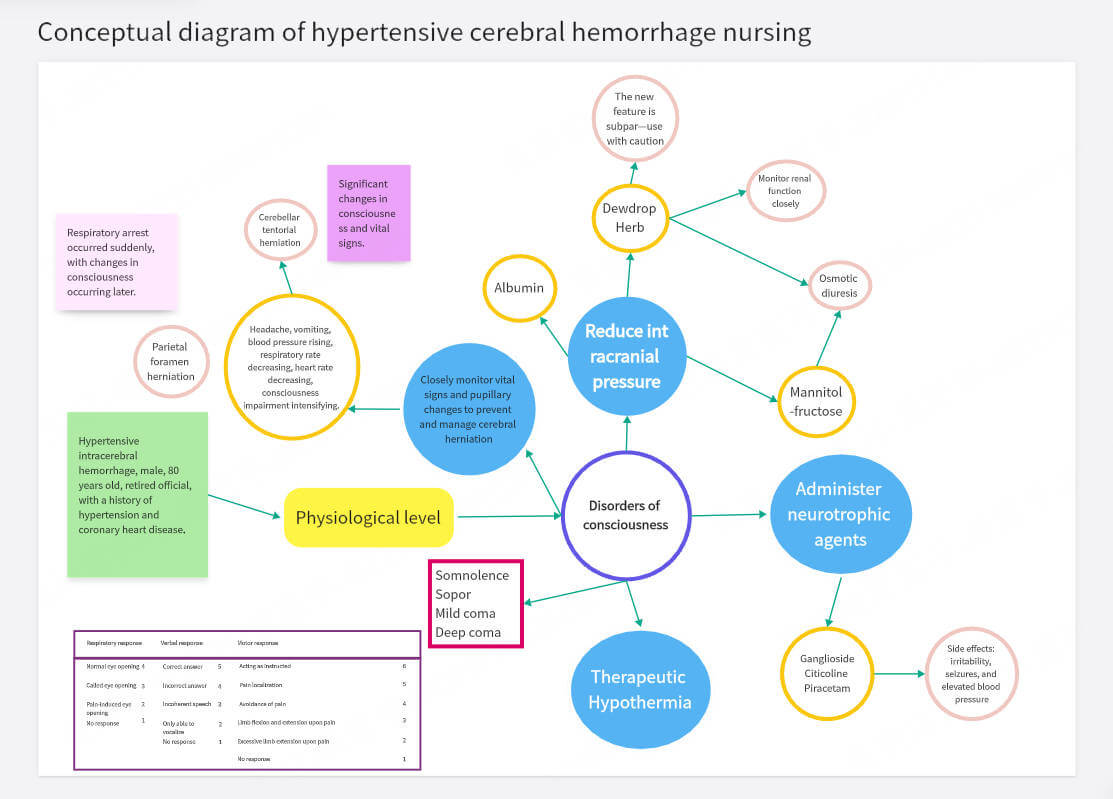
Nursing Concept Map is a network knowledge framework built with nodes and connecting lines centered on core health issues, emphasizing the logical connection between various nursing elements, such as the causal chain of pathological mechanisms, intervention measures and expected results.
eg: Nursing Concept Map for Hypertensive Cerebral Hemorrhage
This concept map helps nurses assess and manage hypertensive cerebral hemorrhage by outlining key aspects such as symptoms, risk factors, treatment plans, and nursing interventions. It visually connects blood pressure management, neurological assessments, and emergency care strategies. Using Boardmix, nurses can quickly modify and expand the map to align with patient-specific conditions.
2. Nursing Flowchart
Nursing Flowchart uses standardized graphic symbols such as diamond table judgment and rectangular table operation to arrange linearly along the timeline, clarifying the operation steps and decision nodes.
Nursing Flowchart is suitable for standardized nursing procedure execution, such as the early postoperative activity process, from assessing pain scores → determining the level of assistive devices → implementing progressive training.
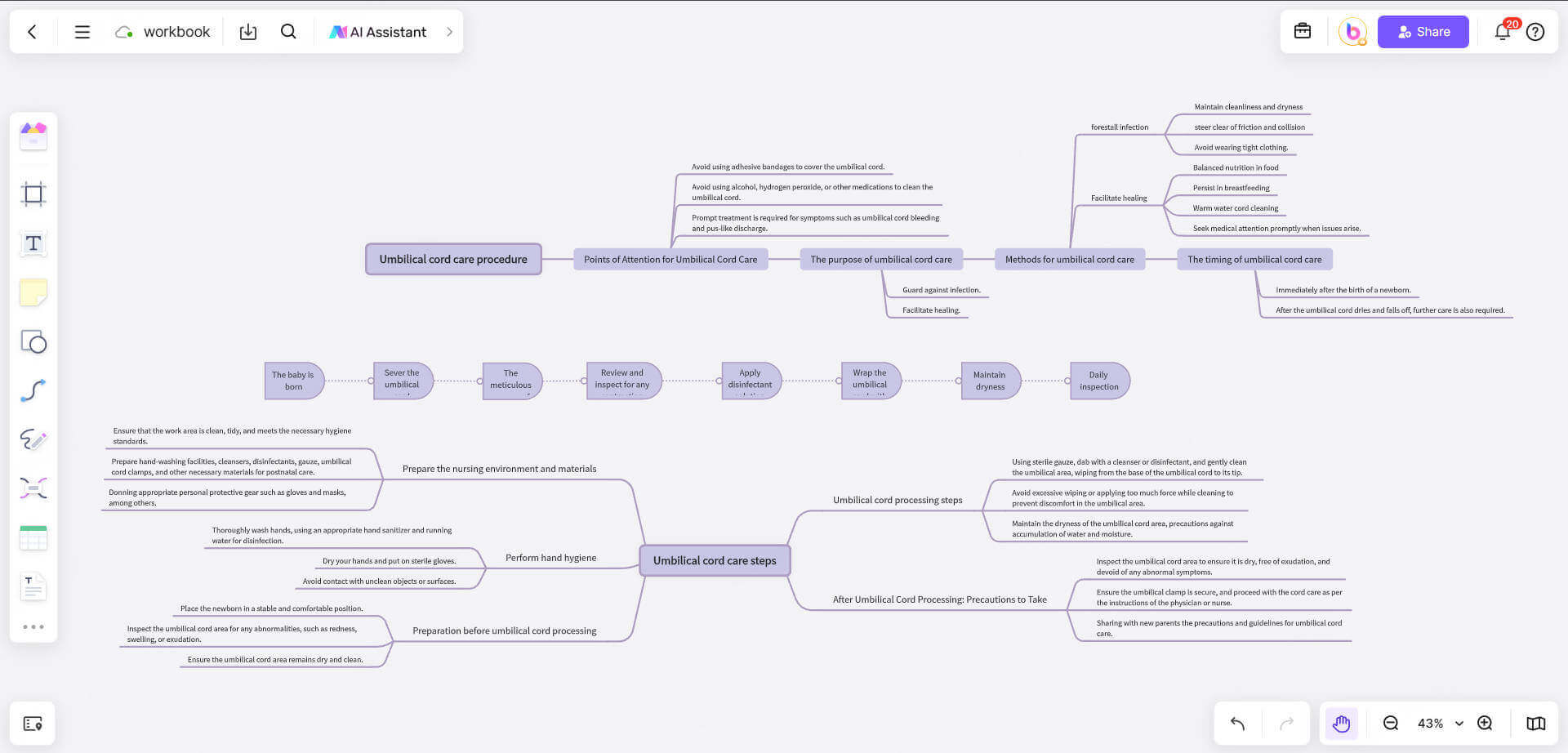
eg 1 : Flowchart for Umbilical Cord Care
A well-structured flowchart simplifies the step-by-step process of umbilical cord care for newborns. It guides healthcare providers through essential actions like cleaning, monitoring for infection, and ensuring proper healing. With Boardmix’s interactive features, nurses can collaborate in real-time to standardize best practices across teams.
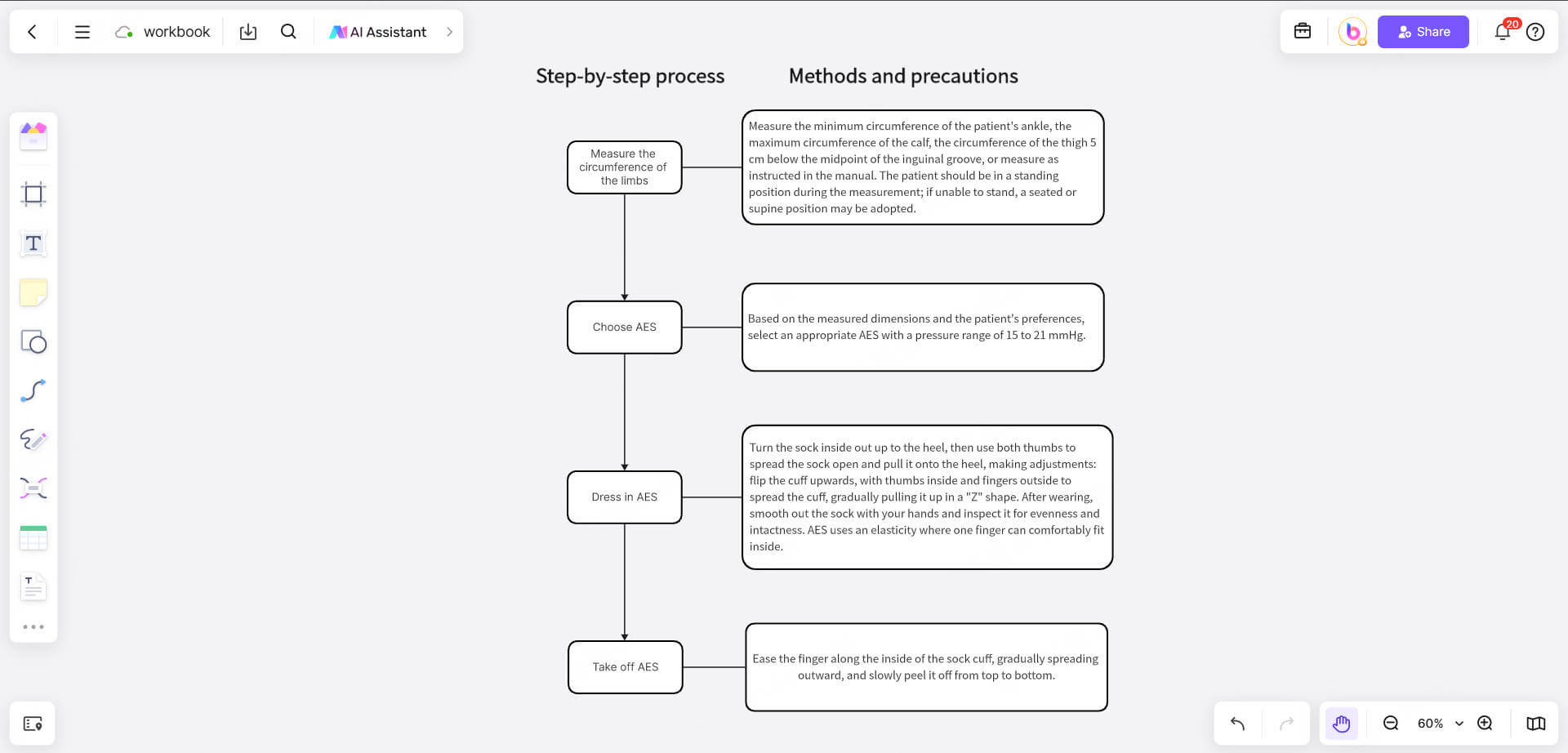
eg 2 : Flowchart for Using Anti-Embolism Stockings
This flowchart outlines the correct procedures for selecting, applying, and monitoring anti-embolism stockings to prevent deep vein thrombosis (DVT). It ensures that healthcare professionals follow proper sizing, application techniques, and patient assessments. Boardmix’s easy-to-use templates allow teams to customize the flowchart based on specific hospital protocols.
3. Nursing Mind Map
Nursing Mind Map diverges and extends in a tree structure, stimulating creative thinking through keywords and color markings.
Nursing Mind Map is suitable for personalized nursing program design. For example, when formulating a non-drug intervention plan for Alzheimer's patients, music therapy branches and nostalgia therapy branches can be extended from the core of "cognitive stimulation".
Why are Nursing Concept Maps Useful for Patient Care
Why is the nursing concept map useful for patient care? It is mainly reflected in the following aspects.
Nursing concept maps help integrate complex information
Nursing concept maps integrate fragmented information such as patient history, symptoms, medication records, nursing goals and interventions into a logically clear network structure through visual means. This systematic presentation can help medical staff quickly grasp the overall condition of the patient, especially when dealing with multiple health problems, which can effectively avoid the omission of key information.
Nursing concept maps can promote multidisciplinary collaboration
As the "common language" of inter-professional teams, concept maps can break down disciplinary barriers. Doctors, nurses, rehabilitation therapists, etc. can understand the focus of nursing synchronously through shared charts and reduce communication errors.
Nursing concept maps can enhance patient participation
When nursing staff use concept maps to explain the treatment path to patients, the visual causal chain (such as "poor blood sugar control → foot ulcer risk → daily inspection process") makes it easier for patients to understand their own conditions.
Nursing concept maps can dynamically assess risks
Through color coding and arrow connections, concept maps can highlight potential risk points. For example, drug interaction nodes are marked in red, and dotted arrows are used to indicate signs of complications that have not yet appeared. This early warning mechanism allows nursing staff to formulate preventive measures in advance.
Nursing concept maps can support evidence-based nursing practice
The nodes of the concept map can be marked with the source of evidence (such as "NICE Guideline Article 5.2") to ensure the scientific nature of the nursing plan. At the same time, it allows flexible adjustment of the structure to adapt to individual needs-the chart of patients with dementia may strengthen the safety protection module, while the postoperative patients highlight the pain management path.
Nursing concept maps can optimize nursing records
Compared with traditional linear records, concept maps can dynamically reflect the evolution of the nursing process. Version comparison can clearly track the trajectory of disease changes and provide a more intuitive chain of evidence in medical disputes.
Nursing concept maps are an effective tool to improve nursing quality. It can not only be an information carrier for nursing, but also a practical clinical thinking training framework.
Conclusion
Creating a nursing concept map is a powerful way to streamline patient care planning, enhance critical thinking, and improve team collaboration. With Boardmix, you can easily visualize complex medical information, organize assessments, and develop effective care strategies—all in one intuitive platform. Ready to enhance your nursing workflow? Try Boardmix today and start creating your own nursing concept map for better patient care!




